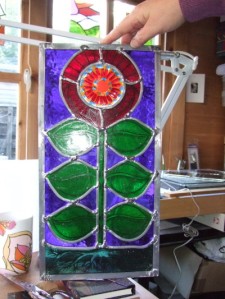Making Your Business work
Angela Townsend a Stained Glass Artist
Current Position
Has a lovely studio in the back garden ( a present from her musician husband) Based in Watford.
Started working with glass five and a half years ago. Her business Red Hen Glass has been going three years but she is still working two days a week at the Institute of Physics so she can pay the bills.
Last year she earned about £700 from her business working 15 hours a week.
Red Hen Glass has a website here which seeks stained glass commissions chiefly for door panels and offers small glass pieces for sale with no dimensions or prices with a link to the Folksy site where there are only sun catchers for sale.
A Folksy store here which sells her sun catchers
A Blog here
Our discussions
We talked about her previous work experience, she has an engineering background and had done an apprenticeship where if something was not right, you had to do it again until you had perfected it. That gives her the patience to master the technicalities of glass work and to be a perfectionist about the finish.
Having been made redundant she then worked in a builder’s merchant. That gives her insight into building projects and how they are organised which will help in the world of architectural glass
She and her husband moved down to Cornwall and she worked in a craft store which is where she learnt how much help customers need to choose products.
Returning to London she re trained as a teacher but was stifled by the limitations of the curriculum but that means if one day she wishes to run workshops she will have a useful background
Architectural glass work
We talked about this piece which she said she would sell for £85 to £90 I asked her how much you would have to pay a tradesman to install that and she thought about £50 Then I gave her THE FACE the one that means you are bonkers. The tradesman is paid better by far than she is.
I got her to describe the commission process breaking it down to time spent Here it is :
- Initial sketches ( face to face with client our heroine travels to them) 90 mins (excluding travel time)
- If the client is not happy another set of roughs are produced ( but lets assume they are bowled over)
- Full scale colour version of sketch 120 mins with recommendations for the glass and colour “I am not a bully but you have to guide people to what is going to work”
- Cartoon drawing 15 mins
- Cutting the glass pieces 180 mins
- Leading 240 mins
- Cement 60 mins
- Solder and finish 30 mins
- So time taken to actually produce this piece 12 hours and 25 minutes.
- There is no materials cost in there and no marketing time allowed.
So the price is hopelessly out and to survive she needs to radically increase it which will mean a change in her clients. She has to go for The Fired Earth customer who pays £450 per square meter for their kitchen glass mosaics ( I kid you not, here is the link Fired Earth)
The sad truth is that people who live in little terraces out-of-town are simply not in a position to commission glass artists to make bespoke pieces for their houses.
My friends, your customers simply can’t be people like you.
I also advised her to take payment in three stages: at initial drawing, at finished drawing and on the completed piece. This does two things: improves the cash flow, and covers you if the commission crashes and burns.
Sun catchers
These are for sale on her Folksy store for £18 this size and if there is an extra border around £25.95 Yeah, she got THE FACE again, obviously the price is too low but the issue is the odd amount. It reeks of mass-produced and imported. NEVER use an odd figure artists simply don’t.
Now I really like these pieces I like their Victorian glass antecedents I think they are very different and instantly recognisable. BUT they are sun catchers. Nobody grand has sun catchers therefore you cannot grace them with a hefty price. Also curtains and blinds and window sill depths and window openings make them difficult to place.
So we needed to come up with a different product and dear reader we did! Exactly the same glass lantern picture tile but presented on the square like this
With a stand ( details dead secret but plotted and all can be made in-house) which will allow it to be displayed on the mantlepiece, in the bathroom with a night-light behind, or on a window sill with daylight coming through. Suddenly it is liberated from sun catcher to light and picture with many more options for where it can go in the house. And, better still, an entirely different price potential. I am advocating £60 for the larger tile and £40 for the smaller and a simplification of the design so they take less time to produce.
If I was a footballer I would be running round the field making ridiculous gestures at this point. Angela was wobbly on the price but when we planned her year to come she was converted.
Here’s another they are lovely aren’t they? All handmade, hand painted. You have to like it, it’s very charming.
Marketing
I persuaded her that she needed two distinct sites and identities Angela Townsend Glass Artist architectural glass site with her hobnobbing with the likely target to be found in the Design Council, Spitalfields Trust, English Heritage, Interiors magazine world and Red Hen Glass selling its fabulous product directly off the already existent Red Hen Glass site and getting editorial roundup mentions to fuel custom. And taking a stall in the likes of Selvedge Magazine fairs and other up market fairs to the Waitrose classes.
Organisation
The more we plotted and planned the more myriad the tasks became and I said how are you going to get all this organised and she said I feel a Gantt chart coming on. her turn to make THE FACE at me I don’t know what that is, but I do now and its a hell of a useful aid
Gantt Chart
It turns out a Gantt chart is a glorified to do list with lots of lovely colouring in.
- Angela showed me how this is done in Excel but the principles are simple.
- Down the left hand side you write all the main areas of things you have to do. These are your headings.
- Then under each heading you break down all the elements you need to do to achieve your goal in that area
- Then with in each heading you consider the order you have to do the tasks in. Some tasks will be dependent on others having been completed .
- Then think about how the first tasks under all the headings interrelate. For example on the chart Angela and I started under marketing it says research fairs, well that has a knock on effect for lots of other activities as the chosen fair date will be a deadline for sorting out the product
- Then block up the coming month of work days across the top. Colour in a few spaces for catch up ( as there are always other things that have to be done) and fill in what you want to get done in that time just by colouring enough squares in line with the task to get it done.
- Then consult you chart and beaver away knowing that you have everything covered and you are progressing to where you want to be.
There is no need to follow this exactly adapt it for your own needs
Aims
I asked Angela where she would like to be this time next year this is her answer
- To have done craft events put my products in front of the customer and got their feedback
- To have developed a separate architectural glass site and worked out some standard designs
- To sort out the Red Hen website so that it offers the small products and to have a bigger selection of designs to offer
All laudable aims but do you see what is missing? I kept prompting her thinking surely she will see the gap but she didn’t. And that is the hub of the matter she made no mention of INCOME.
Nobody anywhere can get a business off the starting blocks if they don’t think and plan for an income.
You have to work out how can I afford to be the best craftsman in the world?
My Advice
SO we worked on the money. Angela needs £1000 a month to live on. That money currently comes from her two-day a week job. Her aim has to be to give up that job to liberate two more working days into her glass business. How is she going to achieve that?
My view was she should concentrate purely on the Red Hen side and get that up and earning properly. I think it is the fastest route. We have an adapted product which I thought could bring in much higher prices if repositioned if you remember I advocated £60 for the larger tile and £40 for the smaller. So she would need to sell 20 large tiles a month or 30 small ones to produce £1000 thats a big ask to achieve in a year consistently in fact its near impossible. She just might achieve that rate by the end of the year but it’s not going to happen in the early months.
So move one is MODIFY YOUR GOAL aiming for the unattainable is for idiots. So we dropped the income to be achieved to £500 a month. Which means she has to continue her outside work for another two years. BUT while she does so as her craft income increases she will achieve a reserve to help her through the low times, holidays and illness.
That goal of £500 means selling 10 large tiles a month that suddenly seems possible. She makes her Gantt chart and off she goes. Pushing with a narrow focus on that product.
Chances
How will she do? What are my reservations? At the moment she takes quite a bit of the weekend off she is not driven but that maybe because she fears failure if she really goes for it I think she has about a 80% chance.
Up till now her glass making has effectively been a hobby. Will she dislike the business side of things so much that she let’s go of the idea of being a self-supporting craftsperson? Its her determination I question, not her ability. I actually think she has a great and saleable product. Buts its going to be dull for a couple of years, no architectural glass until she can afford to liberate those two days from her outside job.
Heres hoping she will liberate her inner business woman.
Further help in these posts:
More on the customers I am suggesting Angela should aim for Juicy Customer Segment
Your crafts business not making you a living yet? diagnostic Chart to help you pin point where its going wrong Not making a living HELP
Want to read about another glass craftsman who is making a living ? Slump Glass Artist
On the brink of starting out? Check your chances Will your crafts business succeed?
Your turn
Talk to me, encourage me, ask me, disagree with my advice – use the comments or come and talk on the Handmade Lives Facebook Page














ART GLASS – Breaking Glass To Make Money: A Beginners Guide To Making Money With Art Glass – Copper Foil And Lead Explained (Volume 1)
Available through Amazon here: https://www.amazon.com/ART-GLASS-Breaking-Beginners-Explained/dp/153685803X/ in print and on Kindle.
#1 Best Seller on Amazon in the Stained Glass crafters category as of 6/6/17.
Available through Barnes & Noble, Wal-Mart & other retailers as well.
This book encompasses knowledge by the professional glass artist Francis Elder II, who has been doing stained glass and art glass work since 1988.
In this book he explains in easy to understand terms the process of going from a part time hobbyist to becoming a paid artisan. This how-to book explains in detail the steps involved that will allow you to follow your dreams of becoming a paid art glass artist.
He details areas such as; incorporating yourself into your art, designs and pattern making, efficiency, production, custom work, safety, how to price your work, installation and service calls, where and how to sell, insurance, commission sales, using social media, marketing as a whole, teaching and more.
ISBN-10: 153685803X
ISBN-13: 978-1536858037
Autographed copies and additional information including a chapter breakdown can be found here: http://www.booksbyelder.com/books/art-glass-breaking-glass-to-make-money-vol1/
Thanks so much for this plain english plan. I am just starting out on my own and have been staring at bank advice for two hours without feeling any further forward. I’m am now ready to start writing my business plan.
Joan Business plan sounds very grand, do bumble toward your goal adapting and trying out as you go. You are a crafter who wants to teach others the enjoyment, you are not an entrepreneur, there is very little money in the direction you are heading so don’t borrow and don’t spend. Sometimes it is not about income but the danger is when you think it can be.
Hi Dixie
Your post really hits the nail on the head for me with my business and has given me a wake up call and I am very interested to read about pricing your products and time and also the type of customers that you should be aiming at and how to go about it. I find I can price products for my friends but when it comes to my own I start dithering and could possibly do with some good advice about that.
Jacqui
Jacqui I suggest you ask a group of fellow artists who are making a reasonable living round for a drink and put out all your products and give all your guests a form with all the products and ask them what price they think you could sell the product at also ask for a suggestion of where to sell your work at the prices they suggest. The forms are anonymous. No conferring. Discard the highest and the lowest on each product look for the just above middle figure.
The question must be not what would you pay but what do you think I could sell it for?
Once you have your prices, do your sums. What profit are you getting on that, can you live off it. Some products might be uneconomic so you have to drop them or modify them.
One piece of practical advice change all you Folksy headings because before you click through you can’t tell what it is you are selling, it needs to say Large notebook ( they can see the design ) don’t say Moleskin in the heading, (why advertise them as they are doing far better than you.) At the moment it could well be a card for £8 . People flip about on the Internet and take in only a tiny bit of what’s there so be very, very clear.
My next post is going to be purely on pricing so once you have read that you will be laughing all the way to the bank.
Hi Dixie
Thank you for your comments and I will take your advice re pricing. I have just changed my Folksy titles as you suggested and also my Etsy ones too:
http://www.etsy.com/shop/jacquidodds?ref=si_shop
I did look at the titles with a fresh pair of eyes and saw that they were far too long and confusing. I have just reread your comment and now noticed that you said not to include the word Moleskine in there. I haven’t taken it out yet as it has only just registered you said not too (sorry – will rethink that). I included it originally as I thought I would get more searches on these shops as they are a well known and respected brand – rather than little old me who no one knows. There does seem to be whole sections etc reserved for Moleskines. What do you think? It may be better at some stage to actually make my own notebooks rather than use the Moleskines.
Looking forward to reading your next post on pricing :-)
Jacqui
Just discovered you this morning, I am 5 years in to (trying to) earning my living as by stained glass craft in France. The pitfalls you have mentioned could have been written just for me. I must get my website focused, be realistic about pricing and target customers. However all these good intentions sent me running off to paint the kitchen this afternoon rather than actually sitting at the keyboard. I think I’m a bit overwhelmed and disappointed in myself, which is perhaps a crafter’s default mode. But I shall make a list and get started tonight. Thank you for all the good advice here.
Claire I looked to see what you are doing and it seems you have three areas, the holidays , the classes and the made by me for sale glass . My guess is that it is this last element that is the least successful.
My solution for you would be to drive forward on the workshops and holidays and even invite well known glass artists to do masterclasses on a profit share. Perhaps even other craftspeople. Drive hard to make that make a living using the time you would have spent on personal craft production and marketing.
Relegate your making to teaching and hobby. If someone takes a class and wants to commission a piece, then wonderful, but don’t focus on that at all. Your own glass making will soar once released from the duty to make money from it.
I guess its not what you intended, the other two areas were supposed to support your making but I think you need to go with the flow on this, your own making will come into its own later. If you can make the holiday business make a good living then the roles that you do like painting the kitchen will be taken on by employees so success will give you your time back.
I think it is simple you are asking too much of yourself you have too wide an area to cover. Focus down and hack away and you will see progress.
Thanks Dixie, you are absolutely right, I am eaking out a living with the classes and b&b yet still spending much of my time trying to boost the stained glass sales and commissions. I shall take your advice and push that energy into making the 1st two areas a real success. I have already lost some of the joy from my craft so am ready to disengage that from money making concerns and get back to working with glass simply for my pleasure. And if I do sell anything that will be a big bonus. Thanks again. Claire
“Up till now her glass making has effectively been a hobby.” I can empathise with this and suspect that it is one of the major problems for many f us full time crafters. Making that transition from hobby to business and doing what sells not just what we like is a major problem for me as well. Fortunately I have a partner with a vicious streak of honesty and big boots so am nagged, cajoled and pushed into it. Don’t get me wrong, I am truly grateful for her support and encouragement. Thanks Dixie, another honest and encouraging article / interview reminding me to get off my backside and run a business LOL.
Pete
Pete, hurrah for your partner
As always an interesting read Dixie and certainly food for thought. I think we should all aim high and then higher again. The glass designs are beautiful and would make lovely sun catchers in the window, thank you both and good luck Angela. One thing I would add it is so much cheaper not to ‘go out’ to work and not until you have been home a while that you realise how far your money can stretch.
Caroline You are absolutely right about how much less you spend if you work from home. Its a really good point and I shall be squeezing that into a post or two Thank you.
You save on travel, lunches, social drinking, need less ready made food as you don’t arrive at your supper so hungry and stressed you will eat the packaging to get at the food. Also your wardrobe can take a hit and you dont do cheer up lunchtime clothes shopping..You are so right. The only Winter downside is the energy bill explodes. Otherwise its all savings. In fact more, you don’t need a cleaner, and you can diy things you would have paid for. In fact it is a miracle anyone can afford to go out to work.
Exactly Dixie, we found the fuel was less as had on constant rather than timed to when we walked through the door, so the bolier did not do cold starts, plus big baggy cosy jumpers, with thick socks are bliss, may be off trend but who cares
No big baggy cosy jumpers right on trend Vogue full of them this season
Can agree with you there Caroline, thanks for your best wishes and comments about my designs. I was terrified when going part time a while back but as well as saving money by not travelling, a side benefit was suddenly finding that my brain became increasingly taken up with creative thoughts and if I needed to sketch something out or think it through, I could, without feeling I should be concentrating on my computer screen or whatever else was happening in the office.